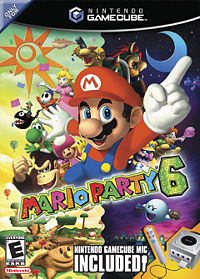Difference between revisions of "Mario Party 6"
| (3 intermediate revisions by 2 users not shown) | |||
| Line 13: | Line 13: | ||
|}} | |}} | ||
| − | '''Mario Party 6''' is the sixth installment of the ''Mario Party'' series and the third of the series to be released for the [[Nintendo | + | '''Mario Party 6''' is the sixth installment of the ''Mario Party'' series and the third of the series to be released for the [[Nintendo GameCube]]. It was packaged with a Gamecube microphone and was the first Gamecube game to utilize it. |
=Story= | =Story= | ||
| Line 26: | Line 26: | ||
=Legacy= | =Legacy= | ||
| + | |||
| + | Nine of this game's minigames would later be included in ''[[Mario Party: The Top 100]]''. | ||
| + | |||
| + | ==Ports/Remakes== | ||
| + | |||
| + | *A six-player [[Arcade#Triforce|Triforce Arcade]] version, ''[[Super Mario Fushigi no Korokoro Party 2]]'', was released exclusively in Japan. | ||
==Sequels== | ==Sequels== | ||
| Line 33: | Line 39: | ||
=See Also= | =See Also= | ||
| − | *[[List of Mario Party 6 | + | *[[List of Mario Party 6 minigames]] |
{{Mario Party Series}} | {{Mario Party Series}} | ||
| − | [[Category: Video Games]][[Category: Mario Games]][[Category: | + | [[Category: Video Games]][[Category: Mario Games]][[Category: GameCube Games]][[Category: Player's Choice]] |
Latest revision as of 10:16, 15 June 2018

| |
| Mario Party 6 | |
| Developer | Hudson Soft |
| Publisher | Nintendo |
| System | Nintendo Gamecube |
| Release Date | JP November 18, 2004 US December 6, 2004 EU March 18, 2005 AU September 15, 2005 |
| Genre | Party |
| Gallery | GH Gallery |
| Rating | ESRB: E |
Mario Party 6 is the sixth installment of the Mario Party series and the third of the series to be released for the Nintendo GameCube. It was packaged with a Gamecube microphone and was the first Gamecube game to utilize it.
Story[edit]
Brighton, the sun begins a dispute with Twila, the moon, over which of them is more impressive. Mario and his friends attempt to calm the dispute in vain, but they soon decide that the power of the Stars could make them stop their argument. So they decide to throw a massive Mario Party in order to fill up the Star Bank enough to stop their feud.
Gameplay[edit]
As with each installment, there are only a few gameplay variations on the usual Mario Party formula of collecting coins and stars on board game levels. The capsule items from the previous game return, redubbed "orbs", and each board will also alternate between day and night every three turns, which effects events and characters on the boards.
The game also has a Solo Mode, in which players embark on one of three boards and battle Koopa Kids in minigames, with the possibility of winning a rare minigame if it is completed. The more traditional Party Mode has six different boards which can be played. The game adds Toadette as a playable character (and is the last game in which Koopa Kid is playable) and features new mic minigames which utilize the Gamecube microphone.
Legacy[edit]
Nine of this game's minigames would later be included in Mario Party: The Top 100.
Ports/Remakes[edit]
- A six-player Triforce Arcade version, Super Mario Fushigi no Korokoro Party 2, was released exclusively in Japan.
Sequels[edit]
The next Mario Party game to be released was Mario Party Advance. Its actual sequel is Mario Party 7, which was the last Mario Party game released for the Gamecube.
See Also[edit]
| Titles in the Mario Party series |
|---|
| Mario Party - 2 - 3 - 4 - 5 - 6 - 7 - 8 - 9 - 10 - Super Mario Party - Superstars -;Jamboree Advance - Mario Party-e - DS - Island Tour - Star Rush - The Top 100 - Korokoro Party - 2 |